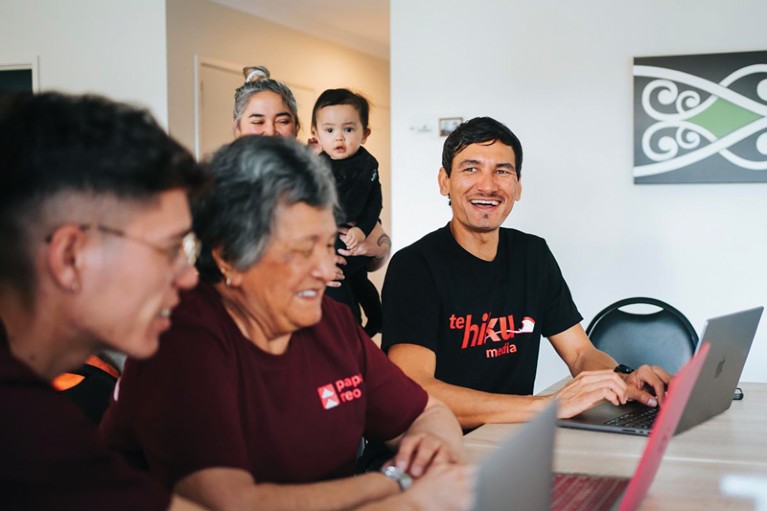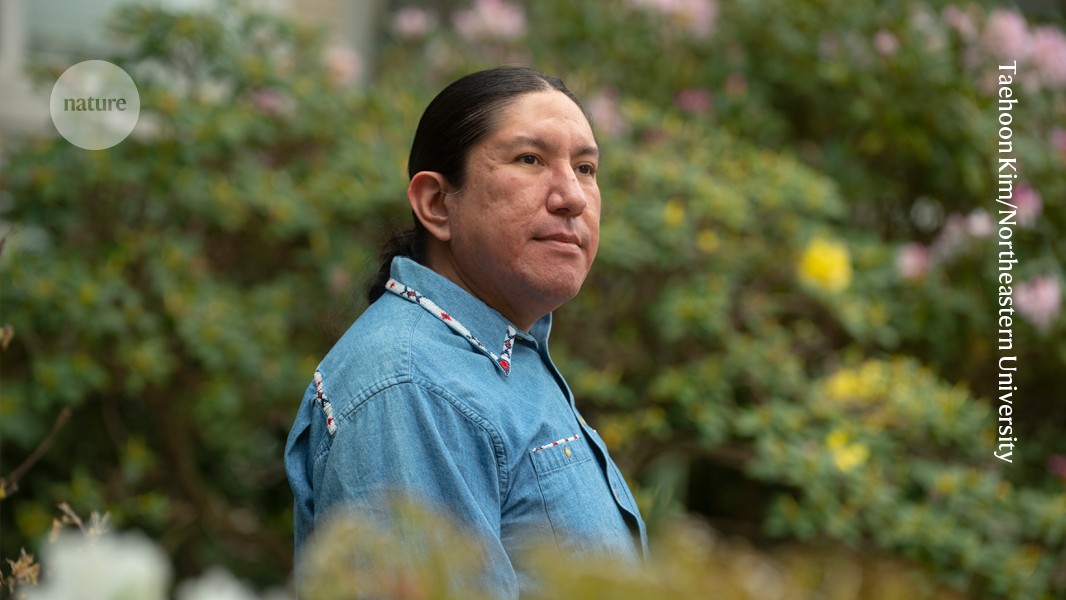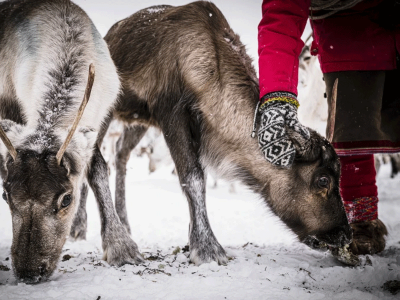Colleagues routinely describe Michael Running Wolf as someone who walks seamlessly between two worlds.
As an artificial intelligence (AI) researcher at the software-development company SynthBee in Fort Lauderdale, Florida, and as co-founder of the First Languages AI Reality (FLAIR) programme at the Mila–Quebec Artificial Intelligence Institute in Montreal, Canada, Running Wolf holds a deep understanding of both the technology underlying AI and the societal benefits it could unlock. And as the son of Lakota and Cheyenne parents, he also knows how technology and data have been weaponized to harm Indigenous communities. Running Wolf therefore approaches his work — in which he revitalizes disappearing languages using AI and virtual-reality tools — with patience, empathy and a healthy dose of scepticism.
“The work that Michael does is so sophisticated and complex because it’s bridging the sacred with the science,” says Estakio Beltran, a partnership adviser at the non-profit organization Native Americans in Philanthropy in Washington DC, who collaborates with Running Wolf and is of Tolteca-Mexica and Tlatoani origin. “We’re fortunate to have him overseeing efforts to reclaim Indigenous languages because his foremost thoughts are to protect and honour Indigenous sovereignty.”
How researchers can work fairly with Indigenous and local knowledge
Running Wolf grew up just outside the Northern Cheyenne Indian Reservation in southeastern Montana, in a remote town called Birney (2020 population: 97). The settlement often lacked running water and electricity, but it was nevertheless a comforting place where he was surrounded by family, literally — everyone in the town was an extended relative through his mother, and Running Wolf didn’t meet a stranger until he left for university age 18. He spent his childhood learning traditional Cheyenne and Lakota artistry and hearing Indigenous languages spoken around him, an experience that is now increasingly rare.
“For decades, the US government oversaw policies of forced assimilation, and as part of that, it was illegal to speak traditional languages or to practise our cultures openly,” he says. “Those policies were often enforced violently, and so we lost generations of fluent speakers that make it really difficult to come back from now.”
Running Wolf was a strong student from a young age, he says, and quickly developed an interest in technology, spurred by his mother’s career as a laser lithographer designing microchips for the computing firm Hewlett-Packard in Colorado. He learnt the basics of computer programming in primary school — including working out how to reprogram his graphing calculator to play games such as Snake. However, when it came to choosing a degree course at Montana State University in Bozeman in 1999, Running Wolf says he picked the then-nascent field of computer science on instinct. “No one in my family, or even my guidance counsellor, actually knew what it was.”
Even as he gravitated towards software development, Running Wolf retained an interest in Indigenous histories, noting that if he hadn’t become an AI researcher, he probably would have become an artist or a poet like his father, who holds a degree in fine arts. When he returned to Bozeman in 2007 after a three-year stint in industry to complete a master’s degree in computer science, Running Wolf’s future bridging the two fields began to take shape.
From exploitation to empowerment: how researchers can protect Indigenous peoples’ rights to own and control their data
For his master’s thesis, Running Wolf drew inspiration from the work of researchers who had used oral histories to trace the origins of tales such as Little Red Riding Hood and to identify items eligible for repatriation under the Native American Graves Protection and Repatriation Act. He spent the summer of 2014 in Siberia, Russia, collecting stories from local Indigenous peoples and using a type of AI called natural language processing to look for similarities between their cultures and those closer to his home. “Ecologically, the area is very similar to the Yellowstone biome in Montana, and so I was interested in how those types of force shape language and culture,” he says. “It stopped being pure computer science and brought in aspects of anthropology.”
Around this time, Running Wolf also met his wife Caroline, a member of the Apsáalooke Nation who speaks 11 languages and was then earning her master’s degree in Native American studies. Together, the two became consumed by thoughts of how computational tools and big data could be used to improve understanding of Indigenous cultures and to reclaim lost languages. The United Nations estimates that roughly half of the world’s 6,700 languages — the majority of which are spoken by Indigenous peoples — are on track to disappear by 2100, yet Running Wolf says there are rarely rigorous plans in place to save them.
“We were both frustrated with the lack of good progress in what was being done at the time,” Running Wolf says. He adds that Caroline has since joined him in co-founding an Indigenous non-profit technology firm called Buffalo Tongue and in managing ongoing projects focused on the applications of AI and immersive technologies for reclaiming Indigenous languages and cultures. “What began as these late-night conversations eventually kicked off this whole new chapter of using technology for language reclamation, and we’ve just become enmeshed in that space.”
The challenges of AI
Indigenous languages differ from those with Latin roots in ways that make them a challenge to reconcile with existing machine-learning frameworks, Running Wolf says. Many Western languages follow a subject–verb–object sentence structure, for example, whereas Indigenous languages tend to be verb-based and polysynthetic, meaning that a single word can include multiple elements that, in English, would be written out as entire sentences. ‘Bird’, for instance, might translate to something like ‘the winged, flying animal that caws’.
Because generative AI models predict the next word in a sentence on the basis of the preceding words, these differences mean that algorithms often do a poor job of recognizing and translating Indigenous languages. However, models perform better when they include Indigenous languages, Running Wolf says, because training on a greater diversity of data ultimately makes the underlying algorithms more adaptive and flexible, just as people who know two languages typically have an easier time learning a third. “But that does create a risk for communities when our language data are suddenly valuable,” he adds.

Staff members at the New Zealand firm Te Hiku Media sought the input of local communities to co-create an automatic speech-recognition system for the Māori language te reo.Credit: Te Hiku Media
Already, there has been a rush by companies such as OpenAI, Amazon and Google to gain access to Indigenous data on language and more; the firms use that information to develop services and products that are then offered back to users, often at a cost. Long-standing mistrust over how their information is likely to be misused has caused some Indigenous communities to disavow themselves of ever turning to AI-based technologies, a stance that Running Wolf respects.
“A lot of this kind of research is without consent, unfortunately, and it has soured people on even trying to engage,” he says. “There’s a lot of risk with AI, and so I think that’s a very healthy response.”
Creating tools for societal good
Running Wolf is working to overcome these hesitations through creating resources by and for Indigenous communities that help to educate them both about their cultures and the technology and, in turn, give them more control over how their data are used.
His early efforts began as employee network groups, including one for Indigenous researchers at Amazon when Running Wolf was there working on the company’s AI-powered assistant, Alexa. Later, he and Caroline were involved in launching two wider initiatives, Indigenous in AI and IndigiGenius. These partner with peer groups such as the information-technology consultancy firm Natives in Tech in Oklahoma City, Oklahoma, the Indigenous Protocol and Artificial Intelligence Working Group and the Abundant Intelligences research project to shape the future of Indigenous-led AI efforts. In 2019, the Running Wolfs participated in two workshops alongside dozens of other researchers to produce a paper outlining how best to ethically design and create AI tools (J. E. Lewis et al. Indigenous Protocol and Artificial Intelligence Position Paper; CIFAR, 2020).
How are researchers using AI? Survey reveals pros and cons for science
In many instances, one challenge these groups face is a lack of fluent speakers of Indigenous languages to both teach the next generation and to help train AI language models. Although children once learnt their ancestral languages at home, they now mostly engage with languages in the classroom. There’s an urgent need, Running Wolf says, for curricula and other resources — not to replace Indigenous speakers, but to train new teachers and standardize how Indigenous languages are taught. “Now, we have a lot of Native Americans trying to learn in classes using methodologies that don’t have good pedagogy or even good metrics for success,” he says.





